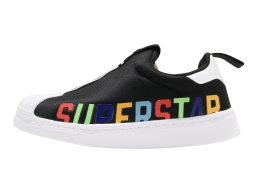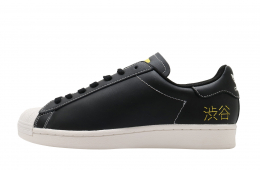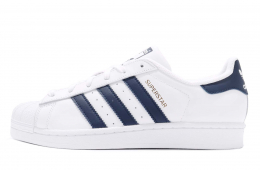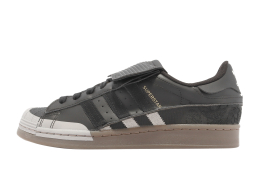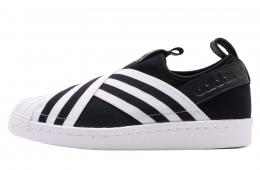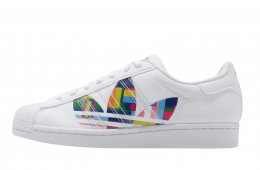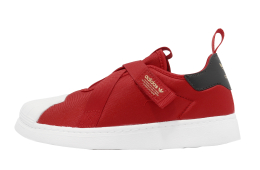Adidas Superstar
The Adidas Superstar, a pinnacle of streetwear culture, first made its debut in 1969 as a basketball shoe. Designed by Adidas as a low-top version of the Pro Model, the Superstar featured a distinctive rubber shell toe cap, which quickly earned it the moniker "shelltoe." This unique design was initially aimed at providing greater protection and durability on the basketball court. Endorsed by NBA players like Kareem Abdul-Jabbar, the shoe gained significant popularity for its performance and style. As the decades passed, the Adidas Superstar transitioned from the hardwood to the streets, becoming a staple in urban fashion and deeply embedded in hip-hop culture. The iconic silhouette, combined with the three-stripe branding and various colorways, cemented its place as a timeless classic in the footwear landscape.
The cultural impact of the Adidas Superstar extends beyond sports and footwear; it symbolizes a fusion of athletic prowess and street credibility. In the 1980s, the shoe gained legendary status largely due to its association with the hip-hop group Run-DMC, who famously wore them without laces and even released the track "My Adidas" as a homage. This endorsement was a groundbreaking moment, marking one of the first collaborations between sportswear brands and music artists. The Superstar's influence continued to expand over the years, embraced by skateboarders, fashion icons, and everyday wearers alike. Today, the Adidas Superstar remains a versatile and highly recognizable shoe, revered for its historical significance and continued relevance in contemporary street fashion.
read moreHistory of Adidas Superstar
History of Adidas Superstar
The Adidas Superstar, one of the most iconic sneakers in the world, has a rich heritage that spans over five decades. Initially designed as performance footwear for basketball, it has evolved into a cultural artifact, embraced by a variety of subcultures from hip-hop to fashion enthusiasts worldwide. The history of the Adidas Superstar embodies a journey of transformation, adaptation, and enduring popularity.
Origins and Early Development
The story of the Superstar begins in the late 1960s when Adidas, then primarily known for its soccer footwear, set its sights on the burgeoning market for basketball shoes. At the time, Converse’s Chuck Taylor All-Star was the dominant shoe on the basketball courts. Looking to break into this segment, Adidas sought to innovate with a design that prioritized protection, durability, and performance.
In 1969, Adidas introduced the Superstar, the first low-top basketball sneaker to feature an all-leather upper. This was a significant departure from the canvas construction of its contemporaries. The shoe also boasted the now-iconic rubber “shell toe,” a piece of technology designed to protect players’ toes and extend the shoe’s durability. The shell toe, alongside the sneaker’s three-stripe branding and herringbone-patterned outsole, set the Superstar apart both functionally and stylistically.
Rise in Popularity
The Adidas Superstar quickly caught the attention of professional basketball players. Kareem Abdul-Jabbar, one of the sport’s dominant figures, was among the early adopters. His on-court performances, combined with his endorsement, gave the Superstar credibility and visibility. By the mid-1970s, the shoe was being worn by over 75% of NBA players, a testament to its design and performance benefits.
However, it wasn’t until the late 1970s and early 1980s that the Adidas Superstar transcended its basketball roots. The transition from sports to street culture was catalyzed by an unexpected source: the burgeoning hip-hop community in New York City.
The Hip-Hop Connection
The late 1970s and early 1980s marked the rise of hip-hop culture, characterized by its unique fusion of music, dance, and fashion. The Adidas Superstar found itself at the heart of this movement, partly due to its association with the b-boy and graffiti subculture. Hip-hop artists, breakdancers (b-boys), and graffiti writers adopted the sneaker for its style and versatility.
One group in particular, Run-D.M.C., played a pivotal role in making the Superstar a cultural icon. The rap trio from Queens, New York, sported the sneakers unlaced and with the tongue pushed out, a style that defied the conventional norms of sneaker-wearing. This distinctive look, combined with their immense popularity, catapulted the Superstar into mainstream fashion. Their 1986 hit song "My Adidas" immortalized the brand in hip-hop lore, and Run-D.M.C. later signed a groundbreaking endorsement deal with Adidas, one of the first between a music group and a sportswear brand.
Global Expansion and Reinvention
The influence of Run-D.M.C. and other hip-hop artists helped the Superstar gain a foothold beyond the United States. Throughout the 1980s and 1990s, the sneaker became popular in Europe and Asia, embraced by a wide array of youth cultures. Skateboarders, punk rockers, and fashion-forward individuals adopted the shoe for its simplicity and statement-making design.
Adidas recognized the Superstar’s growing cultural significance and began to introduce various iterations and collaborations. The shoe was reimagined in different colorways, materials, and special editions, each retaining the quintessential shell toe and sleek silhouette. Collaborations with designers, artists, and other brands further cemented its status as a fashion staple.
The 2000s and Beyond: A Cultural Staple
In the early 2000s, the Adidas Superstar experienced a renaissance. The era marked a period where vintage and retro-inspired fashion were immensely popular. Adidas capitalized on this trend by reissuing original designs and introducing the Superstar II, which maintained the classic aesthetics but featured updated materials and construction for enhanced comfort.
Celebrities and influencers played a significant role in this resurgence. Superstars were seen on the feet of artists like Pharrell Williams, who later collaborated with Adidas to release his own line of Superstars in a spectrum of colors. These collaborations injected new life into the brand and introduced the sneaker to a new generation.
Adidas also engaged in high-profile collaborations with fashion designers and other brands. Partnerships with the likes of Yohji Yamamoto (Y-3), BAPE, and Raf Simons exemplified how the Superstar could be seamlessly integrated into high fashion and streetwear. These limited editions often commanded high prices and elicited frenzied demand, underscoring the sneaker’s enduring allure.
Moreover, Adidas supported various initiatives and commemorative releases that paid homage to the sneaker's storied past. Special editions celebrated milestones, such as the Superstar's 35th and 50th anniversaries, often featuring artist series and collaborations with cultural icons.
Adidas Superstar Today and Cultural Impact
Today, the Adidas Superstar remains one of the brand's flagship products. Its design has remained largely unchanged, a testament to its timeless appeal. The sneaker is a symbol of self-expression, worn by a diverse array of individuals who appreciate its blend of heritage and style.
Its impact on popular culture is undeniable. The Superstar is not merely a shoe; it’s a piece of history woven into the fabric of different global subcultures. Its journey from a basketball court in the 1960s to runways, concert stages, and city streets worldwide is a reflection of its adaptability and universal appeal.
Conclusion
The Adidas Superstar's history is a tale of evolution and cultural resonance. It started as a revolutionary basketball shoe, transitioned into a hip-hop icon, and now stands as a fashion staple. Through strategic collaborations, relentless innovation, and a deep connection with diverse subcultures, Adidas has ensured that the Superstar remains at the forefront of sneaker culture. Its 50-plus-year journey is not just about a shoe but about the enduring impact of design, culture, and brand legacy on our collective consciousness.



